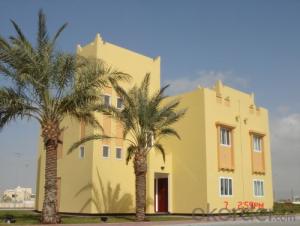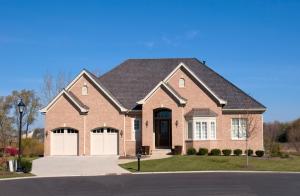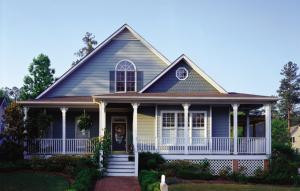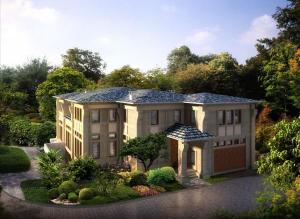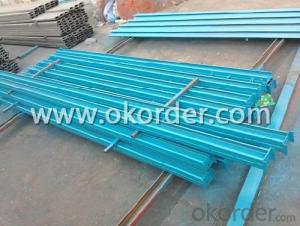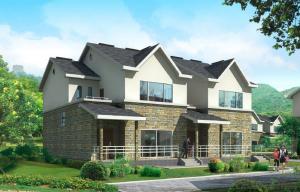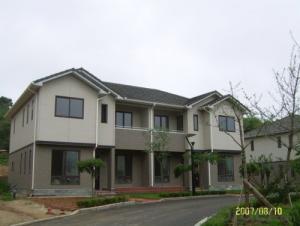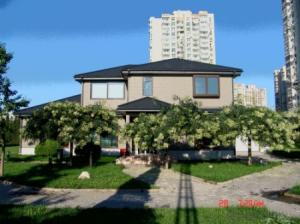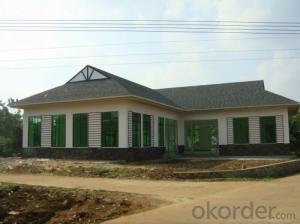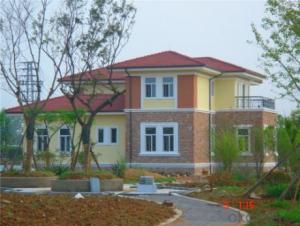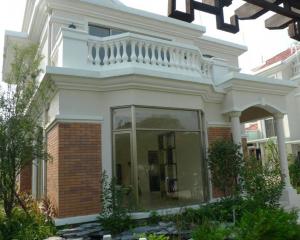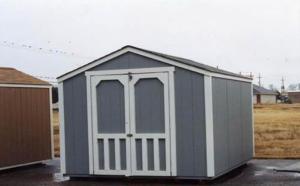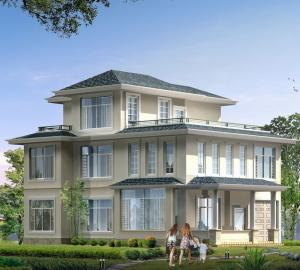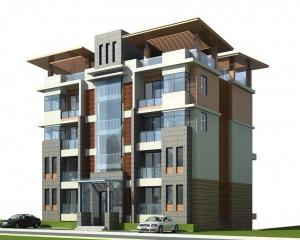Middle East style light gauge steel villa
- Loading Port:
- China Main Port
- Payment Terms:
- TT OR LC
- Min Order Qty:
- -
- Supply Capability:
- -
OKorder Service Pledge
Quality Product, Order Online Tracking, Timely Delivery
OKorder Financial Service
Credit Rating, Credit Services, Credit Purchasing
You Might Also Like
The adavantages of the light gauge steel villa:
1. Better thermal insulation
The advanced exterior overall thermal insulation meets the updated state energy-saving standards for buildings. It refrains from the cold and thermal bridges phenomenon, and keeps buildings away from damages such as dampness, distortion, mildew and corrosion.
The unique heat reflection and ventilation layer design can make better insulation effects. Temperature can be reduced by five to eight degrees. ( In my opinion, this advantage is very suitable for the climatic condition of Middle East )
2. Seismic and Wind Resistance
Withstand the shock of 9 on the Richter scale. The dense light gauge steel and column are connected in flexible method with screws and bolts, which can abosorb the energy of eathquake. There are fittings between foundation and wall, which are resistant to pull out and shear. The total weight of the house is light, which is only 1/6 of the conventional concrete houses. Therefore it has better anti-seismic performance.
Can endure typhoon of 12 levels
There are special fittings among roof, floor, wall and foundation. The strong connection can help resist typhoon of 12 levels.
3. Roof Load-bearing and Fireproof
The structure can be designed according to climate requirements.
Wall and floor slab use special technology which can meet 3h refractory limit.
4. Sound insulation
Improved technology on sound insulation and shock absorption meet the state building standards for sound insulation. Special methods are performed, especially towards the audio frequency ranging from 250-1000Hz which is the most sensitive to ears, in order to create a quiet and comfortable living environment.
5. Moisture-proof and Ventilation
There is a gap between wall and roof truss, so the air can flow inside.
There is one-way ventilation layer in the composite wall, which is able to make the wall "breath". This means moisture can be reduced inside the door.
6. Durable (90 years structure safty guarantee)
Special coating technology enables the structural materials to have the self-restoration function to prevent rust and corrosion.
Envelope materials using new light weight building materials to achieve fire resistant, anti-corrosion and anto-moth.
7. Energy Efficient and Enviromental Protection
Energy Saving: 65-90 energy redution.
Water Saving: The dry construction consumes 10% of water used in traditional constrution.
Land Saving: The inside usable area increases 10%
Environment Protection: Pollution-free construction system.
- Q: Can container houses be designed with a spacious interior?
- Yes, container houses can be designed with a spacious interior. Although containers have a limited width, typically 8 feet, they can be combined horizontally or vertically to create larger living spaces. By removing interior walls, using open floor plans, and incorporating clever storage solutions, container houses can feel more spacious. Additionally, large windows and skylights can be added to bring in natural light and make the interior feel more open and airy. With thoughtful design and maximizing the available space, container houses can provide a comfortable and spacious living environment.
- Q: Can container houses have multiple floors?
- Indeed, container houses are capable of having multiple floors. Their versatility permits them to be stacked, thereby generating numerous levels. This feature enables the optimal utilization of space and the provision of adequate living or working areas for larger families. Nevertheless, it is imperative to verify that the construction is suitably fortified and engineered to withstand the weight of multiple floors, guaranteeing both security and stability.
- Q: Can container houses be designed with natural ventilation systems?
- Yes, container houses can be designed with natural ventilation systems. By incorporating features such as strategically placed windows, vents, and roof openings, container houses can effectively utilize natural airflow to enhance ventilation and maintain a comfortable indoor environment. This approach not only promotes energy efficiency but also allows for a healthier and more sustainable living space.
- Q: Can container houses be designed with a built-in security system?
- Yes, container houses can definitely be designed with a built-in security system. The modular and customizable nature of container houses allows for the incorporation of various security features such as cameras, motion sensors, alarms, and smart locks. These security systems can be seamlessly integrated into the design and structure of container houses, providing homeowners with enhanced safety and peace of mind.
- Q: Can container houses be easily transported?
- Indeed, container houses possess the capability to be conveniently transported. A primary benefit of employing shipping containers as dwellings lies in their inherent mobility. These containers are specifically designed for effortless transportation via trucks, trains, and ships, thereby endowing them with exceptional portability. They are constructed to endure the demands of transportation, such as being stacked and relocated numerous times, rendering them suitable for long-distance journeys. Moreover, container houses can be readily disassembled and reassembled, facilitating simple relocation to various sites or even different countries. This adaptability in transportation renders container houses a compelling choice for individuals in search of a movable or temporary housing solution.
- Q: Can container houses be designed with a yoga or meditation studio?
- Yes, container houses can definitely be designed with a yoga or meditation studio. The modular nature of container houses allows for flexible and customizable designs, making it possible to incorporate specific spaces for yoga or meditation. Architects and designers can include features such as large windows for natural light or skylights for a calming ambiance. Additionally, the open floor plans of container houses provide ample space for a dedicated yoga or meditation area. The use of sustainable materials and eco-friendly designs in container houses also aligns well with the principles often associated with yoga and meditation. Overall, container houses can be transformed into tranquil spaces that cater to the needs of those seeking a dedicated area for yoga or meditation.
- Q: Are container houses soundproof?
- The level of soundproofing in container houses depends on the construction methods and materials used. Steel, the main material of shipping containers, is not known for its ability to block sound. However, by employing proper insulation and soundproofing techniques, container houses can effectively reduce noise transmission. Various methods can be utilized to achieve soundproofing in a container house. Wall cavities can be filled with insulation materials like spray foam, fiberglass, or rock wool to minimize sound transmission. Installing double-glazed windows with acoustic glass can also help reduce outside noise. In addition, sound vibrations can be dampened by using resilient channels or acoustic panels on the interior walls. Acoustic ceiling tiles or cork/rubber underlayment can be installed to further contribute to sound reduction. It is important to keep in mind that despite these measures, container houses may still experience some sound leakage due to the inherent properties of the steel structure. Therefore, it is advisable to seek guidance from a professional architect or soundproofing specialist to ensure the most effective soundproofing solutions for a container house.
- Q: What are the maintenance requirements for container houses?
- The maintenance requirements for container houses typically include regular cleaning and inspection of the structure, ensuring proper insulation and ventilation, addressing any rust or corrosion issues, and maintaining the plumbing and electrical systems. Additionally, maintaining the exterior paint or coating, as well as monitoring and addressing any potential pest infestations, are also important for the upkeep of container houses.
- Q: Are container houses suitable for student accommodation?
- Yes, container houses can be suitable for student accommodation. They offer several advantages that make them an attractive option for students. Firstly, container houses are affordable compared to traditional housing options, which is important for students who often have limited budgets. They can be purchased or rented at a lower cost, making them a more cost-effective choice. Secondly, container houses are highly customizable and can be converted into comfortable living spaces. With the right modifications, they can offer all the necessary amenities such as bedrooms, bathrooms, kitchens, and study areas. These houses can be designed to maximize space utilization and provide a comfortable living environment for students. Additionally, container houses are portable, allowing for easy relocation if needed. This flexibility is beneficial for students who may need to move frequently, whether it is due to changing universities, internships, or other reasons. Container houses can be transported to different locations, providing a convenient accommodation solution for students. Furthermore, container houses are eco-friendly as they are made from recycled shipping containers. This makes them a sustainable and environmentally conscious choice for student accommodation. With the increasing emphasis on sustainability, container houses align with the values of many students who are concerned about the environment. However, it is important to consider some potential drawbacks as well. Container houses may have limited insulation and may require additional heating or cooling measures. They may also have limited space compared to traditional houses, which could be a concern for students who require more room. Additionally, the availability of land and necessary permits for container houses may vary depending on the location, which could pose a challenge for student accommodation. In conclusion, container houses can be a suitable option for student accommodation due to their affordability, customizability, portability, and eco-friendliness. While there may be some limitations, these houses offer a practical and sustainable solution for students looking for affordable and flexible housing options.
- Q: Are container houses suitable for remote work or telecommuting?
- Yes, container houses can be suitable for remote work or telecommuting. These houses are designed to be portable and customizable, making them adaptable to different environments. With the right amenities and technology, container houses can provide a comfortable and functional workspace for remote workers. Additionally, their affordability and sustainability make them an attractive option for individuals seeking a remote work setup in remote or off-grid locations.
Send your message to us
Middle East style light gauge steel villa
- Loading Port:
- China Main Port
- Payment Terms:
- TT OR LC
- Min Order Qty:
- -
- Supply Capability:
- -
OKorder Service Pledge
Quality Product, Order Online Tracking, Timely Delivery
OKorder Financial Service
Credit Rating, Credit Services, Credit Purchasing
Similar products
Hot products
Hot Searches
Related keywords
